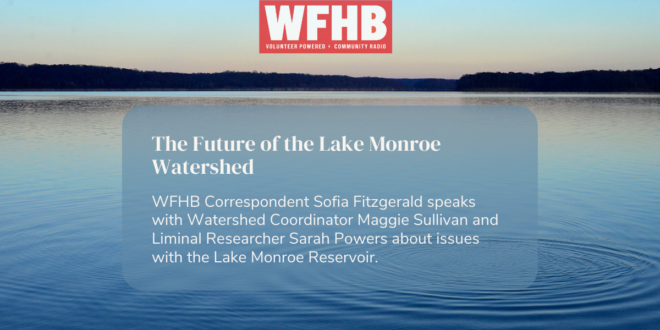Podcast: Play in new window | Download (Duration: 9:28 — 13.1MB)
Subscribe: RSS
Recently, there have been complaints from Monroe County residents regarding the foul taste of tap water within their homes. The main reservoir for Bloomington, IN and Monroe County is Lake Monroe, which is a common source for recreational activities for members of the Bloomington community.
To learn more about this issue with the lake, WFHB News spoke with Sarah Powers, a liminal scientist at Indiana University.
“It’s good to have a nice, diverse community of algae. They’re the basis of the food chain, very critical. It’s just when we have the nutrients start to exceed some point, they can grow in over abundance. And as we’re seeing warmer temperatures later into the summer, we’re starting to increase the amount of total algae,” said Powers.
With many local complaints regarding the tap water in Bloomington, watershed experts and professionals, including Sarah Powers, set out to Lake Monroe to test its waters for what might be the source of this issue. From what this data could find, the lake and its watershed have been experiencing larger algal blooms in its waters since September of 2021, likely causing the foul taste in its tap water.

Sarah Powers elaborates on how she and her team obtained this data and what it means for Lake Monroe.
“We sampled in the lake in the summer of 2020. We also did stream monitoring into the lake once a month for a year,” said Powers. “I don’t think they found a huge amount of change over time, but there are still potential issues in those areas to improve.”
While this doesn’t make the drinking water toxic or harmful, it still presents an issue for residents who perhaps can’t afford to have their water filtered, or those who would be forced to purchase bottled water – which is less heavily regulated – instead of utilizing their home’s tap water.
The algal bacteria found in Lake Monroe is what is known as cyanobacteria. According to the U.S. Environmental Protection Agency (EPA) Cyanobacteria is a microorganism also known as blue-green algae in fresh-water ecosystems that can produce harmful algal blooms or toxins. They have the ability to harm aquatic ecosystems, drinking water supply, and people who come in close contact via recreational activities such as swimming or fishing.
Sarah Powers further explains why this form of cyanobacteria is posing a threat to Lake Monroe’s reservoir and watershed.
“As we see increases in temperature, longer summers fluctuations in the amount of rainfall, it changes the amount of algae,” said Powers. “Historically, it was more of a July-August problem; now it’s lingering into September-October, where we’re seeing longer blooms.”
Luckily, Friends of Lake Monroe, a local non-profit dedicated to the protection of the lake, has developed a management plan to address the issue of growing cyanobacteria in Lake Monroe. This management plan is a long-term goal to prevent Lake Monroe from producing any excess algae and continue to keep Bloomington’s water source clean and healthy. Because of the nature of this plan and the lake, this plan won’t see any noticeable changes for at least a decade or so.
Watershed Coordinator Maggie Sullivan and her team at Friends of Lake Monroe created this watershed management plan in which she expands on in more detail.

“We gathered all that data together and created this watershed management plan that lays out a 20 year action plan for how we protect and improve water quality in the lake,” said Sullivan. “One of the things that was driving this process of why we felt this was important is the increasing occurrence of harmful algal blooms.”
Because the City of Bloomington has not declared any official warning regarding the algal blooms in Lake Monroe, one can assume that these blooms have not reached the toxicity levels required to be harmful in the city’s drinking water supply. Unfortunately, there isn’t much the city of Bloomington can do in terms of policy or legislation due to the fact that the Lake Monroe Watershed does not fall completely within Monroe County lines, but within four other counties as well, making it difficult for local governments to mandate any legislation over the watershed.
Maggie Sullivan explains the nuances of the county lines and how that affects local and state legislation.
“One of the challenges of watershed work is that watersheds span multiple jurisdictions,” said Sullivan. “One of our goals is to get them all collaborating together and saying here we have this plan. Now, we know we need to do so let’s work together to make that happen.”
While these algal blooms have not greatly impacted the reservoir yet – especially during the winter months – this begs the question of whether these blooms will become toxic or will it cause the lake to eutrophy?
Maggie Sullivan explains the science behind this question and what it means for Lake Monroe
“If we don’t do anything, there’s a chance that the lake could get more eutrophic, meaning higher nutrient levels and more common harmful algal blooms.”
While the cyanobacteria blooms in Lake Monroe are cause for concern, we still have organizations like Friends of Lake Monroe and wonderful scientists like Sarah Powers willing to help the Bloomington community and make our city a safer place for everybody here.
If you’d like more information on Friends of Lake Monroe please go to their website at friendsoflakemonroe.org.
 WFHB Bloomington Community Radio
WFHB Bloomington Community Radio


